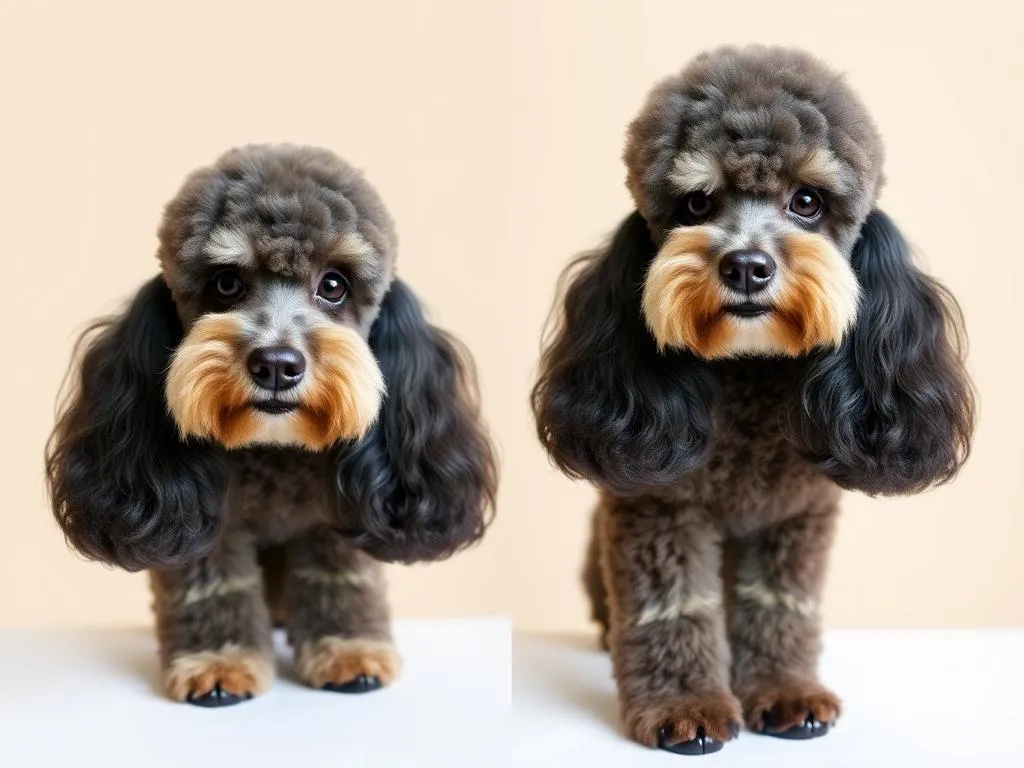
Introduction
Poodles are one of the most recognizable dog breeds in the world, known for their intelligence, agility, and distinctive curly coats. Originating in Germany as water retrievers, they were later refined in France, where they became popular as companion animals. Today, Poodles come in three sizes: Standard, Miniature, and Toy, each with unique grooming needs due to their varying coat types and lengths. Grooming is not just a matter of aesthetics; it’s essential for maintaining your Poodle’s health and well-being. Regular grooming helps prevent matting, reduces the risk of skin infections, and promotes a healthy coat.
When it comes to poodle grooming styles, the options are abundant, and choosing the right one is crucial to match your lifestyle and preferences. In this article, we will delve into various grooming styles suited for Poodles and explore the fundamental aspects of caring for their exquisite coats.
Understanding Poodle Coat Types
Types of Poodle Coats
Poodles have three primary coat textures: curly, wavy, and corded.
- Curly Coats: These coats are dense and tightly curled, providing excellent insulation. They require regular grooming to prevent matting and tangling.
- Wavy Coats: This type has a looser, more flowing texture that may require less frequent grooming than curly coats but still needs regular attention to keep it looking its best.
- Corded Coats: A rarer texture, corded coats form long, rope-like strands. They require specialized grooming techniques and are less common in the pet world.
Understanding these coat types is essential for determining the right grooming routine and style for your Poodle.
Poodle Sizes and Their Grooming Needs
Poodles come in three different sizes, each requiring specific grooming practices:
- Standard Poodles: They typically have the most substantial coat and may require more frequent grooming due to their size and coat density.
- Miniature Poodles: Slightly smaller, they have similar coat types to Standard Poodles but may require less grooming time.
- Toy Poodles: The smallest of the three, Toy Poodles might have more delicate coats, necessitating gentle grooming techniques.
When selecting a grooming style, it’s important to consider the size of your Poodle, as this will influence the grooming methods and frequency needed.
Essential Grooming Tools
Basic Grooming Supplies
To effectively groom your Poodle, you will need some essential tools:
- Brushes and Combs: A slicker brush is ideal for detangling, while a wide-toothed comb can help remove loose hair and prevent matting.
- Grooming Scissors and Clippers: Quality grooming scissors are crucial for trimming around sensitive areas, while clippers can help maintain the overall length of the coat.
Advanced Grooming Tools
For more specialized grooming needs, consider investing in advanced tools:
- De-shedding Tools: These can help remove loose fur, especially during shedding seasons.
- Dematting Combs: Essential for tackling any tangles or mats that form in your Poodle’s coat.
- Specialty Tools: Various tools are available for creating specific styles, including various clipper attachments for different lengths.
Having the right tools makes grooming not only easier but also more enjoyable for both you and your Poodle.
Popular Poodle Grooming Styles
Puppy Cut
The Puppy Cut is a popular choice among Poodle owners, especially those who prefer a low-maintenance grooming routine. This style features a uniform length of about one to two inches all over the body.
Benefits: The Puppy Cut is easy to maintain and keeps your Poodle looking adorable. It also minimizes matting and tangling, making it perfect for active Poodles who love to play outdoors.
Continental Cut
The Continental Cut is one of the most iconic Poodle grooming styles, often seen in dog shows. This style features a shaved hindquarters, with the front legs and head left fuller.
Pros: This cut accentuates the Poodle’s elegant stature and is visually striking. However, it requires regular maintenance to keep the fuller areas looking neat.
Cons: The Continental Cut demands a higher level of grooming knowledge and commitment, making it less suitable for novice owners.
English Saddle Cut
The English Saddle Cut is similar to the Continental but features a more even distribution of hair throughout the body. The hindquarters are left fluffy, while the front legs and head are trimmed shorter.
Unique Features: This style is often chosen for its classic appearance and is perfect for showing. It requires regular grooming to maintain the shape and style.
Suitable Occasions: This cut is ideal for formal events or dog shows where appearance matters.
Lamb Cut
The Lamb Cut is characterized by a soft, fluffy appearance reminiscent of a lamb’s coat. The fur is typically left longer, creating a rounder, softer look.
Ideal for Low Maintenance: This style is great for owners who want a cute, cuddly look without the extensive grooming demands of other styles. Regular brushing is still necessary, but the overall maintenance is more manageable.
Modern and Creative Styles
In recent years, there has been a surge in trendy grooming styles for Poodles, including artistic color applications and unique patterns shaved into their coats.
Considerations: When opting for these modern styles, consider your Poodle’s personality and lifestyle. While they can be fun and expressive, they may require more frequent touch-ups and maintenance.
Grooming Techniques for Different Styles
Basic Grooming Techniques
Establishing a basic grooming routine is essential for keeping your Poodle’s coat healthy. Here’s a step-by-step guide:
- Brush Daily: Regular brushing helps prevent mats and tangles.
- Bathing: Bathe your Poodle every 4-6 weeks, using a dog-specific shampoo to maintain coat health.
- Drying: After bathing, thoroughly dry your Poodle with a towel or a blow dryer on a low setting.
- Clipping and Trimming: Regular trims are essential, especially for longer styles.
Techniques for Each Style
- For the Puppy Cut: Use a clipper with a guard to maintain even length, and trim around the face and feet for a polished look.
- For the Continental Cut: Focus on creating distinct shapes; use scissors for detailing and a clipper for the shaved areas.
- For the English Saddle Cut: Ensure symmetry in the coat by regularly measuring and trimming to maintain balance.
- For the Lamb Cut: Use a longer guard on clippers, and maintain a fluffy look by brushing out knots frequently.
Professional Grooming vs. DIY
While some owners enjoy grooming their Poodles at home, others may prefer to seek professional help.
When to Seek Professional Help: If you’re aiming for a complex style like the Continental Cut or if your Poodle is particularly sensitive, a professional groomer can be invaluable.
Pros and Cons of DIY Grooming: Grooming at home allows for flexibility and can deepen your bond with your pet. However, it requires practice and the right tools to achieve specific styles.
Grooming Frequency and Maintenance
Recommended Grooming Schedule
The frequency of grooming largely depends on your Poodle’s coat type and style:
- Curly Coats: Requires brushing every day and professional grooming every 4-6 weeks.
- Wavy Coats: Brush 2-3 times a week, with professional grooming every 6-8 weeks.
- Corded Coats: Requires minimal brushing but should be groomed professionally every 8-12 weeks.
Seasonal Considerations
Adjusting your grooming routine according to the seasons is vital.
Summer Tips: Consider shorter cuts to keep your Poodle cool, and increase the frequency of baths to manage dirt and sweat.
Winter Tips: Longer cuts can provide extra warmth; however, be mindful of ice and snow accumulation in the fur, which requires regular checks and cleaning.
Health Considerations in Grooming
Skin and Coat Health
Regular grooming is not just about aesthetics; it plays a significant role in maintaining skin and coat health.
Importance of Regular Grooming: It helps remove dead skin cells, reduces the risk of matting, and promotes blood circulation, resulting in a healthier coat.
Common Skin Issues: Poodles can suffer from skin allergies and infections. Regular grooming can help identify skin issues early on, allowing for prompt treatment.
Ear and Nail Care
Poodles are prone to ear infections due to their floppy ears. Regular ear cleaning is essential.
Techniques for Ears: Use a vet-recommended ear cleaner and cotton balls to gently clean the ear canal.
Nail Trimming: Poodles require regular nail trimming every 3-4 weeks to avoid discomfort and potential injury.
Conclusion
Grooming is an integral part of being a responsible Poodle owner. Understanding the various poodle grooming styles available can help you choose the right one that fits both your lifestyle and your dog’s needs. Regular grooming not only enhances your Poodle’s appearance but also contributes to their overall health and happiness. Whether you prefer a classic style or a modern twist, finding the right grooming routine is essential for your furry friend.









